The Autobiography of Wasyl Palijczuk
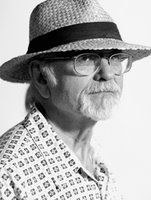 Wasyl Palijczuk's sculpture, "Welcome," at McDaniel College in Westminster, MD throws up its open hands in greeting. His combined photograph/print/drawing of an old man in the Ukraine shucking corn glows with vivid color—warm orange and bright reds. His small soapstone carving, "The Caregiver," depicts a child wrapped in the arms of a serene, grandmotherly woman. According to Wasyl, who was born in the Carpathian Mountains, he was alone most of his childhood; his father, who worked for the Poles, was first arrested by the Russians and then later by the Nazis. After living out the war by himself in Germany, Wasyl emigrated to the U.S., spending time in a children's home in New York before being sent alone by train to Baltimore. His first home, he says, was the one he moved into in Charles Village during the Baltimore riots of 1968.
Wasyl Palijczuk's sculpture, "Welcome," at McDaniel College in Westminster, MD throws up its open hands in greeting. His combined photograph/print/drawing of an old man in the Ukraine shucking corn glows with vivid color—warm orange and bright reds. His small soapstone carving, "The Caregiver," depicts a child wrapped in the arms of a serene, grandmotherly woman. According to Wasyl, who was born in the Carpathian Mountains, he was alone most of his childhood; his father, who worked for the Poles, was first arrested by the Russians and then later by the Nazis. After living out the war by himself in Germany, Wasyl emigrated to the U.S., spending time in a children's home in New York before being sent alone by train to Baltimore. His first home, he says, was the one he moved into in Charles Village during the Baltimore riots of 1968. 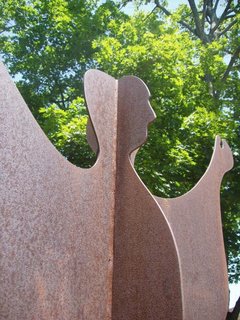
"Whatever I paint comes out of my heart, my brain, my background," says Wasyl. "Whatever you see, you know sooner or later it has to do with me." This claim of autobiography at first seems strange, given his art—almost invariably bright, celebratory, and humane—and then his early history, marked by poverty and war. Where in the record of the many paintings, drawings, sculptures, and prints that fill his studio is the dark color of loneliness, the aggressive brush stroke of violence, the cramped and hollow detail of hunger? Where is the bitterness?
**
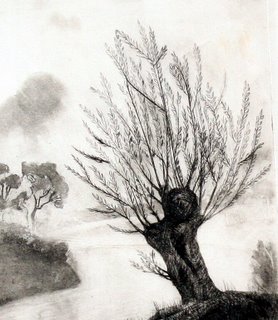 Wasyl is an artist of intuition, his painting and sculpture a result of unplanned exploration. As he says, "I take a canvas and start smearing things on it, start developing it. I have to look into it and turn it and see what comes to mind." This you can see in the many half-finished, half-abstract canvasses he has leaning against the walls, paintings he will come back to many times, adding figures or scenes as they rise out of the paint and from of his imagination. Even in the more figurative works, the Ukrainian scenes, the willow trees and rivers, you sense a study of memory and time, a reaching back for a 60-year-old sensation that takes form as the canvas is worked.
Wasyl is an artist of intuition, his painting and sculpture a result of unplanned exploration. As he says, "I take a canvas and start smearing things on it, start developing it. I have to look into it and turn it and see what comes to mind." This you can see in the many half-finished, half-abstract canvasses he has leaning against the walls, paintings he will come back to many times, adding figures or scenes as they rise out of the paint and from of his imagination. Even in the more figurative works, the Ukrainian scenes, the willow trees and rivers, you sense a study of memory and time, a reaching back for a 60-year-old sensation that takes form as the canvas is worked.And given this method, this free association, we assume the end product is indeed autobiographical, a recording of his inner developments, his thoughts and feelings. The outheld wings of the owl carved into the massive chunk of granite in his "Fountain" at Westminster are thus the open shape of his ideas. And the richly colored, amorphous, and contemplative shapes of his Mexico watercolors bring to mind the color fields of Rothko, the attempt to make concrete a spiritual process.
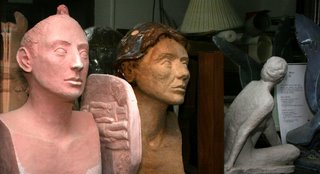
What's more, it's no contradiction to Wasyl to paint, on the one hand, his own version of Russian iconography, his semi-abstracted Mary and Child, and on the other to make a drawing of Jewish religious life. "People say, hey, what are you doing here? Well, I am an artist," he insists, "I am expressing feelings, I am expressing myself." For Waysl, the "myself" is not limited to one culture, region, or background, but includes all the cultures and countries with which he's been in contact, the human experience he has known. One can come to understand that in many ways the "myself" of Wasyl's art is a universal, that the autobiography of one man is the biography of us all.
**

But this again begs the question: Where the misery? Where the darkness? How in the process of time, memory, and experience has Wasyl omitted, or rather we should say transformed, the turmoil he's seen? Perhaps the answer lies in his approach to life, a manner remarkably similar to his method in art. In speaking of his past, Wasyl is fond of the word accident, the word puzzle. "All my life was a puzzle," he says. "I never predicted it. I got my job [teaching] at Western Maryland College accidentally. I didn't ask for it, I was going to open a sculpture studio. My whole life was an accident." He also talks of his introduction to art in these terms, telling me how as a boy of 5, alone at home, he saw a blank white wall and in the stove a pile of ashes. "For some stupid reason, something told me to pick [those ashes] up, smear it on my finger, try it on the wall…I didn't know what art was. I had no training. It was almost like I was pushed into it."
His discovery of art then, as well as his career as an artist and teacher, rose out of the materials, the opportunities, around him, much the same way the figures in his sculptures emerge from the piece of stone or block of wood. Life is an accident, some of it fortuitous, some less so, but all of it a possibility. For his troubles as a 5-year-old budding artist, his father came home and beat him. The lesson, Wasyl says, was to stay away from art, one obviously not taken to heart. Rather this experience, and the many that came after in his young life, seemed to teach Wasyl a resilience and an openness, even a predilection, to the bright colors of the world in spite of its darker tendencies.
**
One painting I did not see but which Wasyl described to me was inspired by an event of some 40 years ago. A boy of about 15 decided to climb the Berlin Wall. He scaled the western side, which was cement, and when he reached the top, the communists shot him. The boy fell and landed between the western wall and the barbed wire fence of the east. There he lay wounded, the west unable to cross over and help him, the east apparently unwilling. "So the kid," Wasyl says, "this totally stupid, innocent thing, is bleeding to death because of t
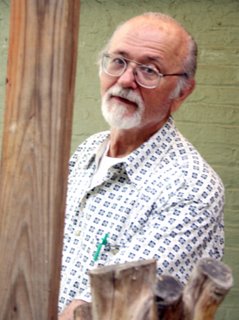 wo stupid governments." In reaction, fueled by his anger, his passion, the experiences of his life, Wasyl painted: "There was a very abstract body, lying between the sides," he tells me. "And he's reaching, barely reaching with his hand, over the wall, and there's the sun, and he's reaching for light, or freedom."
wo stupid governments." In reaction, fueled by his anger, his passion, the experiences of his life, Wasyl painted: "There was a very abstract body, lying between the sides," he tells me. "And he's reaching, barely reaching with his hand, over the wall, and there's the sun, and he's reaching for light, or freedom." 
8 Comments:
Thank you for this. I loved especially, "the 'myself' is not limited to one culture, region, or background, but includes all the cultures and countries with which he's been in contact, the human experience he has known."
Thanks again, Myfanwy. We really appreciate your support and interest.
I love this, I'm so glad you pointed out that this is live!!! His work is amazing as is yours...xo
Hi, Patricia. Glad you liked. Thx.
Some excellent analysis of an extremely thoughtful and talented man and his work. Thanks for taking us to a place outside of the city.
Thanks again, E to G, for coming.
A lovely piece.
Thankee, Laura.
Post a Comment
Subscribe to Post Comments [Atom]
<< Home